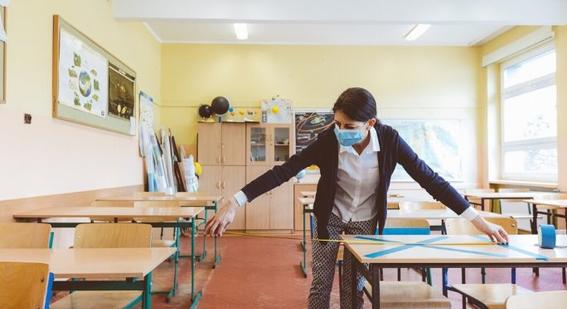Rethinking pedagogy In education for the post-COVID-19 world
A blog from Eric Bruillard, University of Paris, EDA research unit

As a scholar who has studied the use of technology in education for the past three decades, I would like to share a historically informed account of the impact of the COVID-19 pandemic on pedagogy in education.
Indeed, the use of technology in education has a long history, which began long before digital technology, and scholarly investigation into it has brought to light some of the major issues that make us contain our excitement about digital education solutions in response to COVID-19.
Firstly, what is pedagogy?
The word ‘pedagogy’ originated in Ancient Greece, where it meant a teacher leading a child. As defined by the Cambridge Dictionary, pedagogy is the study of the methods and activities of teaching.
Pedagogy can be contrasted with another term which shares similar roots: andragogy.
Pedagogy vs andragogy
While pedagogy has its origins in the Ancient Greek for leading children, andragogy means leading adults. It has since come to mean the theory, methods and activities involved in teaching adult learners.
In light of the widespread adoption of digital education solutions during the COVID-19 pandemic, I would like to discuss four interrelated observations that characterise the situation experienced with lockdown and school closures. I will also offer some reflections on school reopening and pedagogy in a post-COVID-19 world.
COVID-19 confirms 30 years of research findings on the use of digital technology in education: four interlinked observations about pedagogy in education
- Inequality in online learning
First of all, we have witnessed inequality associated with school closures and the shift to distance learning. This comes as no surprise to researchers in the field.
In my recent article examining the history of arguably the most researched educational TV programme, Sesame Street, I discussed some of the main ideas around the assessment of technology use in education.
By tracing the evolution of Sesame Street, which was created with an ambition to ‘give disadvantaged children the same opportunities as middle-class children’ in the mid-1960s, I showed that this ambition was never fulfilled and that technology use in education tends to widen, rather than close, gaps between the privileged and the disadvantaged.
As Justin Reich has brilliantly summarised, research has repeatedly shown that hybrid teaching, which combines face-to-face and online education, could be slightly better than purely face-to-face instruction, and that there is a risk for socio-economically disadvantaged populations to be left behind in transitioning to online learning.
It is not just a question of a simple divide in terms of equipment and access (even if these divides exist in almost all countries), but also of multiple divides associated with language, cognition, culture, etc. which require forms of compensation and additional support.
Much meaningful support is provided locally, which leads to the second observation:
- The importance of local initiatives and associations
In response to COVID-19 in France, we witnessed various local innovations such as associating the distribution of meal baskets (to address the closures of school canteens) with the provision of printed homework (to compensate for the inability to print them at home) and trying to solve, at least partially, the great difficulty in reacting to school closure.
Education is not simply a technical matter, but it integrates human dimensions and social ties, the disappearance of which is detrimental. In the United States, the Education Week Teacher reported a heart-warming story of a teacher who, after posting his lesson on the web and sending emails, took his small portable whiteboard and went to a student's house, and explained what she didn’t understand through the glass door.
This nicely leads to the third point:
- Teaching is a profession
It is not easy to improvise oneself as a teacher, even if many situations lead to so-called informal teaching and learning. Taking into account all unique personalities in the classroom, trying to make them progress together, repeating and diversifying modes of approach and explanation, locating misunderstandings and trying to respond to them... teaching is not simple.
You must also be ready to improvise and adapt to unforeseen circumstances. This is what many teachers have done when it has become necessary to take charge of so-called ‘pedagogical continuity’. (See "We Always Make It Work": Teachers' Agency in the Time of Crisis.) However, this brings me to the fourth point I want to make:
- Many teachers are ill-prepared to conduct distance classes, which is more than just giving exercises and homework
Indeed, sending written instructions, providing lessons to be printed or read on the screen and assigning homework are not very complicated tasks. It's almost like what used to be called ‘correspondence courses’. For unprepared parents, it’s like importing a closed and frightening version of school to the home, which they are asked to take over.
Thinking differently about education outside the classroom, opening up to activities of exploration and discovery, sharing, diversifying moments, giving a role to the collective – all of these constitute challenging yet rewarding opportunities, which should enrich the training and professional development of teachers.
What now?
An article entitled 'The Coronavirus Exposes Education's Digital Divide' in the New York Times, dated 17 March 2020, which I read at the beginning of the lockdown, gives some keys to understanding the problems for pedagogy in education posed by the pandemic. Written by Raymond Zhong, it deals with the Chinese situation, while announcing that other countries will face the same reality as the epidemic spreads.
In China, many rural students do not have the connection or equipment to learn remotely. According to Chinese government statistics cited in the article, between 56 and 80 million people are reportedly without Internet connection and 480 million people reportedly said they were not going online for other reasons, including not knowing how to get online.
The author reports various cases of students, such as those who had to walk for hours and bear the cold weather to listen to online courses on mountain tops, the only place to get a sufficient signal. A picture illustrates this situation, the caption explaining that children from a village went to the mountains to ‘find online courses’. Teenagers are seen in the forest around what appears to be a fire. Everyone is looking at their mobile phones, and some of them have a notebook as well.
Of course, this experience of pedagogy in education is not limited to China. In Vietnam, for example, students are building small huts in places where the Internet is available to continue classes.
Illustrating the gradual return of students to school, another picture of the New York Times article shows high school and college students on their first day back to school.
The content of the article and the associated images refer to the digital divide and especially the access divide. The efforts that young students in rural areas, alone or in groups, must make to attend classes are remarkable, as is their inventiveness. This shows the importance of school and leads to a slightly different view of things – a positive view of certain aspects of school closure.
The image of the class with the pupils neatly dressed in red uniform, each with his or her mask, provides a striking contrast: does everything return to ‘normal’ after the crisis?
Changing approaches to pedagogy in education
In French, we use the expression ‘faire l'école buissonnière’ which means ‘to go for a walk, to have fun instead of going to school’. A more familiar English translation might be ‘to play truant’.
Originally, ‘truant’ was an underground school held in the open field. This meaning dates back to the time of Martin Luther, when several clandestine schools were established in the countryside in opposition to the clergy-run schools in the cities.
Here, there is a paradox, since one has to ‘truant’ to connect to the school. In the image of the Chinese class, one has the impression of an enclosed school, cut off from life, with a military order. The issue is to build a school where children are reunited and which remains open to life and allows both discipline and emancipation.
When trying to consider how to change schools now, one should avoid limiting oneself to a mere technical vision and simply advocating for addressing challenges of infrastructure, connectivity and access to devices.
According to the French sociologist Bernard Lahire (interview in Mediapart newspaper), children from disadvantaged families often only experience school-based learning at school: their parents are not very qualified, they are not used to transmitting school knowledge pedagogically, and some of them cannot read or write. For these children, it is only at school that they interact with adults who can introduce them to school knowledge.
Rethinking Pedagogy: exploring the Potential of Digital Technology in Achieving Quality Education
In the recently published UNESCO report, Rethinking Pedagogy: Exploring the Potential of Digital Technology in Achieving Quality Education, with my colleague Yoko Mochizuki from MGIEP, we tried to highlight the key role of teachers; if digital education media and resources have the potential to open up new possibilities for pedagogy in education, it requires consideration of those actors who use them (both educators and learners) and the context in which they are used.
We also attempted to show that digital does not replace paper. Textbooks remain essential tools, and their key role in a digital era is to offer structure for core content and act as an organiser of a pool of abundant external resources.
A US survey (National Survey Tracks Impact of Coronavirus on Schools 10 Key Findings) provides interesting views about problems connected to school closure.
It is no surprise that teachers are concerned about students falling behind in mathematics, but a surprising result was that teachers felt that the arts are tough to teach remotely. In any case, art education is certainly an essential aspect of a child’s learning, which is not reduced to measurable skills assessed in tests but helps to develop a student to become a whole person.
Pedagogy in education in a post-COVID world
So what should we expect in a ‘post-COVID’ world? It is certainly not the development, in a narrow sense, of artificial intelligence in school education towards standalone digital and personalisation for better performance in the short term, that will provide solutions adapted to the pandemic. In my view, reviewing teacher training and enhancing teacher collectives are priority actions when it comes to pedagogy in education.
Many thanks to Yoko Mochizuki for correcting and improving the first version of this text.




